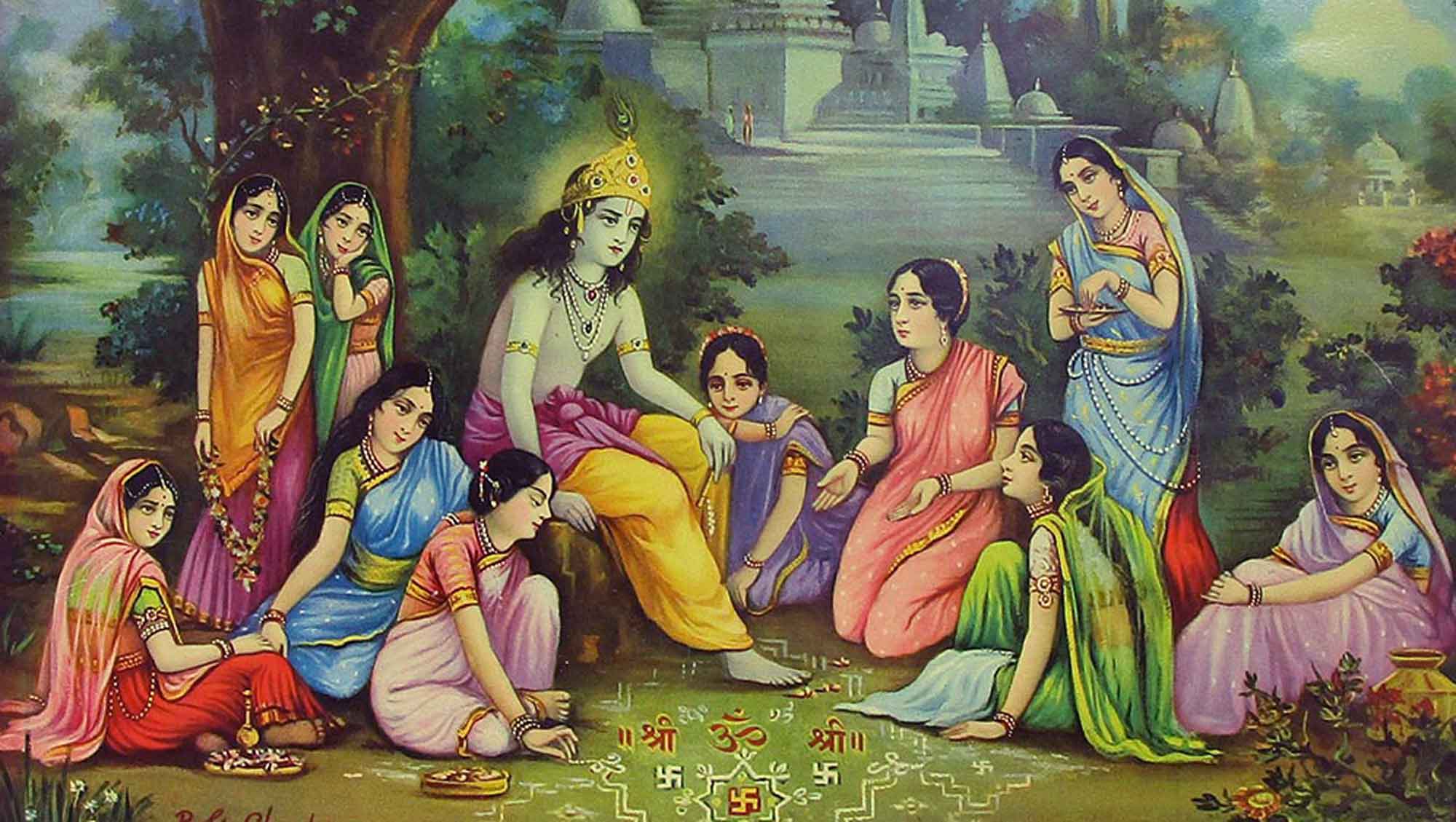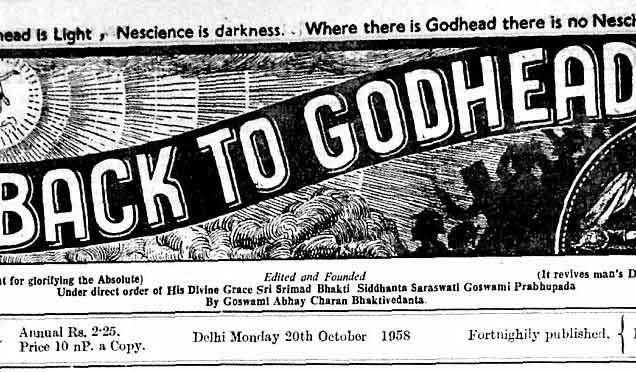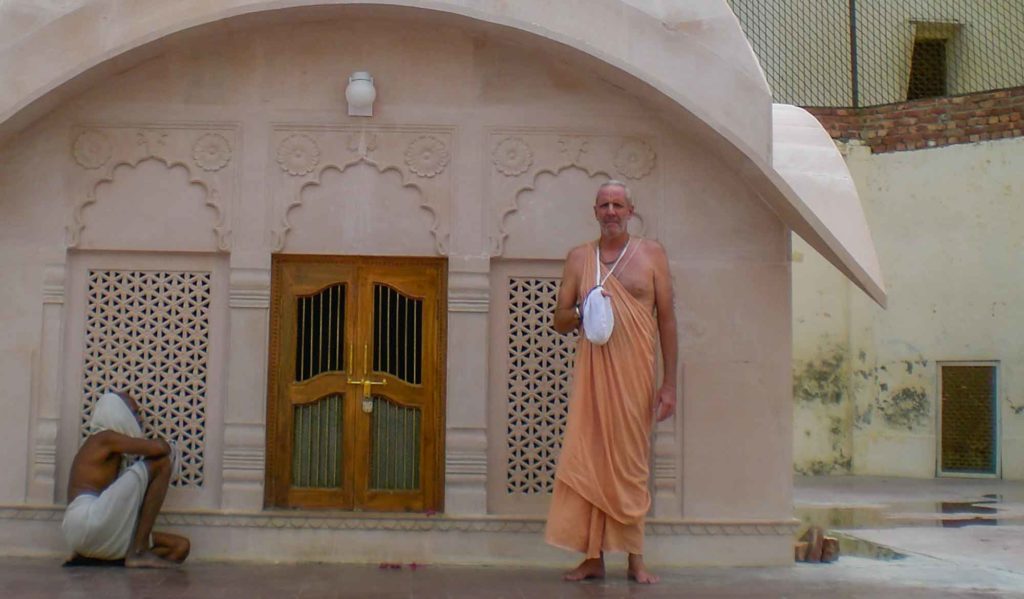Overview
Rūpānuga Bhajana’ is an article written by Swami B.G. Narasingha in 1992. Narasingha Maharaja delineates what it means to be a rūpānuga in the Gauḍīya sampradāya, and explains the unique position of Śrīla Rūpa Gosvāmī Prabhupāda.
There is a Bengali song by Śrīla Bhaktisiddhānta Sarasvatī Ṭhākura which goes as follows:
mahāprabhu śrī caitanya, rādhā-kṛṣṇa nahe anya
rūpānuga janera jīvana
“Mahāprabhu Śrī Caitanya, who is non-different from Śrī Śrī Rādhā and Kṛṣṇa, is the very life of those Vaiṣṇavas who follow Śrīla Rūpa Gosvāmī.” (Śrī Guru-paramparā)
Those who follow the teachings of Śrīla Rūpa Gosvāmī are known as rūpānugas. Śrīla Rūpa Gosvāmī was the chief disciple of Śrī Caitanya Mahāprabhu and it was he whom Mahāprabhu chose to head the generations of future followers and worshippers of Śrī Śrī Rādhā and Kṛṣṇa.
Once, while living in Purī, Śrīla Rūpa Gosvāmī composed a verse and after writing it on a palm leaf scroll, he went to bathe in the ocean. At that time, Śrī Caitanya Mahāprabhu visited the residence of Śrīla Rūpa Gosvāmī and saw the verse written on the palm leaf:
priyaḥ so ’yaṁ kṛṣṇaḥ saha-cari kuru-kṣetra-militas
tathāhaṁ sā rādhā tad idam ubhayoḥ saṅgama-sukham
tathāpy antaḥ-khelan-madhura-muralī-pañcama-juṣe
mano me kālindī-pulina-vipināya spṛhayati
“O my friend, now I have met My beloved Kṛṣṇa at Kurukṣetra. I am that same Rādhā, and now that We are meeting together it is most wonderful. Still, within I desire to go to the bank of the River Yamunā and under the shade of the trees I wish to hear Him play the fifth note of His sweet flute which charms the mind.” (Cc. Antya-līlā 1.79)
Śrī Caitanya Mahāprabhu read this verse and was overwhelmed by ecstatic love. When Śrīla Rūpa Gosvāmī returned, Mahāprabhu slapped him mildly and said, “My heart is very confidential. How did you know My mind in this way?” After saying this the Lord firmly embraced Śrīla Rūpa Gosvāmī.
Mahāprabhu then inquired from Svarūpa-Dāmodara, “How could Rūpa understand My heart?”
Svarūpa-Dāmodara replied, “I can understand that You have already bestowed Your causeless mercy upon him, otherwise it would not be possible for Rūpa to have understood You.”
Thereupon, Mahāprabhu was very pleased and requested Svarūpa-Dāmodara to kindly give further instructions to Rūpa in the matter of transcendental mellows (rasa).
After some time, Mahāprabhu came to visit Śrīla Rūpa Gosvāmī accompanied by Svarūpa-Dāmodara, Rāmānanda Rāya and other intimate devotees. Mahāprabhu requested Śrīla Rūpa Gosvāmī to read a number of verses that he had composed. Being very humble and shy by nature, Śrīla Rūpa Gosvāmī remained silent. Svarūpa-Dāmodara then read the previous verse compiled by Śrī Rūpa which was so much liked by Mahāprabhu as well as the following verse:
tuṇḍe tāṇḍavinī ratiṁ vitanute tuṇḍāvalī-labdhaye
karṇa-kroḍa-kaḍambinī ghaṭayate karṇārbudebhyaḥ spṛhām
cetaḥ-prāṅgaṇa-saṅginī vijayate sarvendriyāṇāṁ kṛtiṁ
no jāne janitā kiyadbhir amṛtaiḥ kṛṣṇeti varṇa-dvayī
“I do not know how much nectar the two syllables ‘kṛṣ-ṇa‘ have produced. When it is chanted, it seems to dance within my mouth. I then desire thousands of mouths. When that name enters my ears, I desire millions of ears. And when the name dances in the courtyard of the heart, it conquers the activities of the mind, and all the senses become paralysed. (Cc. Antya-līlā 1.99)
Hearing these and many more verses compiled by Śrīla Rūpa Gosvāmī, all the Vaiṣṇavas became jubilant. Rāmānanda Rāya especially showed interest in the writings of Śrīla Rūpa Gosvāmī and being very pleased with him, began to praise the qualities of Śrī Rūpa as if he had a thousand mouths. Rāmānanda Rāya said, “This is not a poetic presentation. It is a continuous shower of nectar. Indeed, it is the essence of all ultimate realisations. The wonderful descriptions of Rūpa are superb arrangements to express transcendental loving affairs of Rādhā and Kṛṣṇa. Hearing them will plunge the heart and ears of everyone into a whirlpool of supreme transcendental bliss.”
The significance of the praises of Śrīla Rūpa Gosvāmī offered by Svarūpa-Dāmodara and Rāmānanda Rāya may be considerably more meaningful to the readers when we take into account the ontological hierarchy in the spiritual world. According to Śrīla Kavi Karṇapūra, the author of Gaura-ganoddeśa-dīpikā, it is said that in kṛṣṇa-līlā, Rāmānanda Rāya was the gopī named Viśākhā and Svarūpa-Dāmodara was the gopī named Lalitā Sakhī. Both Lalitā and Viśākhā are the very intimate associates of Śrīmatī Rādhārāṇī, who alone can satisfy the desires of Lord Mādhāva. Lalitā and Viśākhā are considered the personal expansions of the serving mood of Śrīmatī Rādhārāṇī, thus they are the two chief assistants in the mādhurya-rasa – the love affairs between Rādhā and Kṛṣṇa.
Directly serving under Lalitā Sakhī in the mādhurya-rasa are the mañjarīs, i.e. the younger cowherd girls. This mañjarī group of servitors mainly consists of new recruits in the mādhurya-rasa and due to their young age, they have been given the most sacred type of pure service to Rādhā and Kṛṣṇa. The service performed by the mañjarī class we are to conceive most respectfully and attentively.
When Rādhā and Kṛṣṇa are in secrecy, in a private place, the older sakhīs do not like to approach the Divine Couple at that time for fear of causing a slight disturbance. Rādhā and Kṛṣṇa may feel some shyness in the presence of the older sakhīs. But the younger gopīs, the mañjarīs, can enter there without disturbing the free mixing of Rādhā and Kṛṣṇa. This mañjarī group of servitors in the mādhurya-rasa is headed by the gopī named Rūpa Mañjarī. To perform their service, the mañjarīs headed by Rūpa Mañjarī, sometimes go to that place where Rādhā and Kṛṣṇa are intimately engaged in divine love dalliances. Such a high and intimate scope of service is available to no other group of servitors than that of the mañjarīs. Rūpa Mañjarī, who leads the mañjarī group, has appeared in gaura-līlā as Śrīla Rūpa Gosvāmī and Śrī Caitanya Mahāprabhu has given him the supreme position as head of the Gauḍīya sampradāya (Rūpānuga sampradāya).
As our beloved Guru Maharaja, Śrīla Bhakti Rakṣaka Śrīdhara Deva Gosvāmī Mahārāja used to say:
“The camp, the sampradāya of Śrī Caitanya Mahāprabhu is known as the Rūpānuga sampradāya. There our fate and our fortune is located. Now we have to conduct ourselves in such a way that naturally we can connect with that highest, purest spiritual conception from here. We must not allow ourselves to be satisfied with anything less than this highest ideal. That should be the highest goal of our life.”
So, the real meaning of rūpānuga-bhajana is nothing less than that – the highest ideal of the highest spiritual conception. Following in the footsteps of Śrīla Rūpa Gosvāmī ever desiring his mercy, falling prostrate at his lotus feet and praying again and again and again to be enlisted in his group of servitors.”
That is rūpānuga-bhajana.
Related Articles
- Śrī Śrī Rādhā Kṛṣṇa & The Fountainhead of All Tattvas by Śrīla Bhakti Pramoda Purī Gosvāmī
- A Prayer Composed on the Occasion of the Disappearance of Śrīla Gadādhara Paṇḍita by Śrīla Bhakti Pramoda Purī Gosvāmī
- The Appearance of Śrīla Gadādhara Paṇḍita by Śrīla Bhakti Rakṣaka Śrīdhara Deva Gosvāmī
- Śrī Śarādīyā Pūjā by Śrīla Bhakti Rakṣaka Śrīdhara Deva Gosvāmī
- Śrī Lalitā Devī and Śrīmatī Rādhārāṇī by Śrīla Bhakti Rakṣaka Śrīdhara Deva Gosvāmī
- The Appearance of Rādhā-kuṇḍa by Śrīla Bhakti Rakṣaka Śrīdhara Deva Gosvāmī
- From Śraddhā to Prema by Śrīla Bhakti Gaurava Narasiṅgha Mahārāja
- Gāyatrī as Rādhārāṇī by Śrīla Bhakti Gaurava Narasiṅgha Mahārāja
- My Guru is Rādhārāṇī by Śrīla Bhakti Gaurava Narasiṅgha Mahārāja
- The Greatest Negative by Śrīla Bhakti Gaurava Narasiṅgha Mahārāja
- Śrī Rādhāṣṭamī by Śrīla Bhakti Gaurava Narasiṅgha Mahārāja
- Śrīla Śrīdhara Mahārāja and the Gem of All Conceptions by Śrīla Bhakti Gaurava Narasiṅgha Mahārāja
- Planets of Faith by Śrīla Bhakti Gaurava Narasiṅgha Mahārāja
- Rādhā-Pāda Darśana by Śrīla Bhakti Gaurava Narasiṅgha Mahārāja
- The Definition of Faith by Gaura Gopāla Dāsa
Further Reading
Pilgrimage with Swami Narasiṅgha – Part 7: Keśī Ghāṭa
Continuing with our pilgrimage series, this week Śrīla Narasiṅgha Mahārāja takes us to Keśī Ghāṭā where he tells us about Madhumaṅgala’s meeting with the Keśī demon, what Keśī represents, and how Śrīla Prabhupāda almost acquired Keśī Ghāṭa. Mahārāja also narrates his own experience. This article has been adapted from a number of talks and articles by Narasiṅgha Mahārāja.
Prema Dhāma Deva Stotram with the Narasiṅgha Sevaka Commentary – Verses 61-65
In verses 61 to 65 of 'Prema Dhāma Deva Stotram', Śrīla Śrīdhara Mahārāja narrates the pastime of Śrī Caitanya at Caṭaka Parvata In Purī and explains how the scriptures produced by Brahmā and Śiva are ultimately searching for the personality of Mahāprabhu who is merciful too all jīvas, no matter what their social position.
Prabhupāda Śrīla Sarasvatī Ṭhākura’s Visit to Ayodhyā
With the forthcoming observance of Śrī Rāma Navamī, we present 'Prabhupāda Śrīla Sarasvatī Ṭhākura’s Visit to Ayodhyā' written by Śrīla Bhaktisiddhānta Sarasvatī Ṭhākura Prabhupāda from The Gaudīyā magazine, Vol 3. Issue 21/ In December 1924, after visiting Benares and Prāyāga, Sarasvatī Ṭhākura visited the birth-site of Śrī Rāmācandra in Ayodhyā.
Śaraṇāgati – The Only Path to Auspiciousness
In this article, 'Śaraṇāgati - The Only Path to Auspiciousness', Dhīra Lalitā Dāsī analyses the process of śaraṇāgati (surrender) beginning with śraddhā (faith). She also discusses the role of śāstra and the Vaiṣṇava in connection with surrender.
Pilgrimage with Swami Narasiṅgha – Part 7: Keśī Ghāṭa
Continuing with our pilgrimage series, this week Śrīla Narasiṅgha Mahārāja takes us to Keśī Ghāṭā where he tells us about Madhumaṅgala’s meeting with the Keśī demon, what Keśī represents, and how Śrīla Prabhupāda almost acquired Keśī Ghāṭa. Mahārāja also narrates his own experience. This article has been adapted from a number of talks and articles by Narasiṅgha Mahārāja.
Prema Dhāma Deva Stotram with the Narasiṅgha Sevaka Commentary – Verses 61-65
In verses 61 to 65 of 'Prema Dhāma Deva Stotram', Śrīla Śrīdhara Mahārāja narrates the pastime of Śrī Caitanya at Caṭaka Parvata In Purī and explains how the scriptures produced by Brahmā and Śiva are ultimately searching for the personality of Mahāprabhu who is merciful too all jīvas, no matter what their social position.
Prabhupāda Śrīla Sarasvatī Ṭhākura’s Visit to Ayodhyā
With the forthcoming observance of Śrī Rāma Navamī, we present 'Prabhupāda Śrīla Sarasvatī Ṭhākura’s Visit to Ayodhyā' written by Śrīla Bhaktisiddhānta Sarasvatī Ṭhākura Prabhupāda from The Gaudīyā magazine, Vol 3. Issue 21/ In December 1924, after visiting Benares and Prāyāga, Sarasvatī Ṭhākura visited the birth-site of Śrī Rāmācandra in Ayodhyā.
Śaraṇāgati – The Only Path to Auspiciousness
In this article, 'Śaraṇāgati - The Only Path to Auspiciousness', Dhīra Lalitā Dāsī analyses the process of śaraṇāgati (surrender) beginning with śraddhā (faith). She also discusses the role of śāstra and the Vaiṣṇava in connection with surrender.








